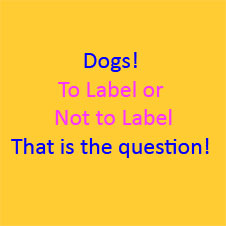We’re all so well informed these days about
reading food labels? Particularly of course when it comes to food. It strikes
me as rather amusing then, that there are 2 conflicting pieces of advice
regarding dogs and labels: Read the food label but ditch the "dominance" or "protective" label or whatever....
But here's a thought. Perhaps it would help, if we applied an "ingredients" list approach to labelling our dogs? Labels are good, but only if we know the content.
After all, long are the days where our manufactured food simply said "bread" - the list of ingredients in bread is breath-taking! And equally, simply labelling a dog as reactive gives us very little information about what's truly going on.
Read
The Food Label!
Do you actually know what’s in your dog’s
food? Most of us have only just started to read the labels on our own foods and
become conscious of the levels of salt and sugar etc. Would we even think about
our dogs or pets?
Indeed, when you have a look, it may come
as a surprise that you are still none the wiser! There may well be ingredients
such as meat and animal derivatives, by-products and certainly a
whole pile of “E” numbers. Surprised? Shocked?
Interestingly, it’s not necessarily ALL
bad. Manufactured dog food is created to ensure that every mouthful is
nutritionally balanced. It’s not like our “ping” food where we only expect that
to be one meal, balanced out with our 5 fruit and veg over the rest of the day.
But, perhaps a look at the label may stimulate some questions.
Labels can compartmentalize our thoughts.
Some may label a particular dog “aggressive” or perhaps the softer
“reactive” term. Some even say their dog gets “over-excited” or are not
“aggressive” – “just afraid”.
If does of course help to “name” things.
The trouble is that there can be so many different “ingredients” accumulating
to create the reactive or fearful or aggressive behaviour. With that one label,
we limit our ability to consider what’s actually going on in the dog’s mind.
They may bark aggressively at people. They may strain on the lead and start to
become aggressive – simply because they want to run and play (but have become
so frustrated that they are truly angry). The root emotion of each of these
behaviours is obviously completely different. Further, these dogs may well have
other issues in their lives such as fireworks fears or separation issues or indeed
boredom.
So, how about a dog behaviour ingredient
list?
Reactive
Dog: aggressive to people; scared of traffic noise;
doesn’t like the lead being put on; barks at the postman; loves food; loves to
play with owner.
Isn’t that more helpful?
For more information on dog behaviour and on
food, have a look at PawsAbility.co.uk for information on 1-1 help, workshops
and talks.
First Published in the Northern Times, March 18
Author - Anna Patfield , www.PawsAbility.co.uk


